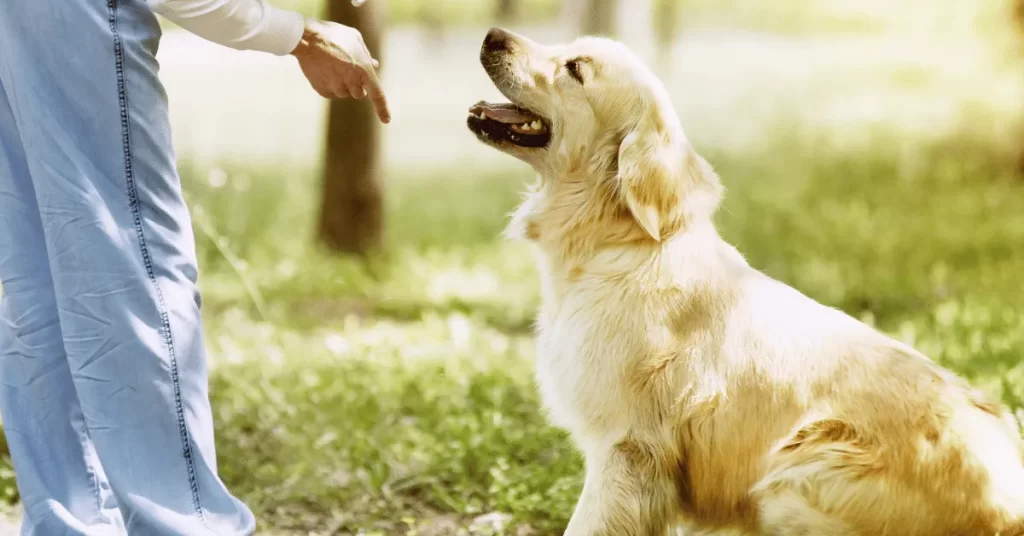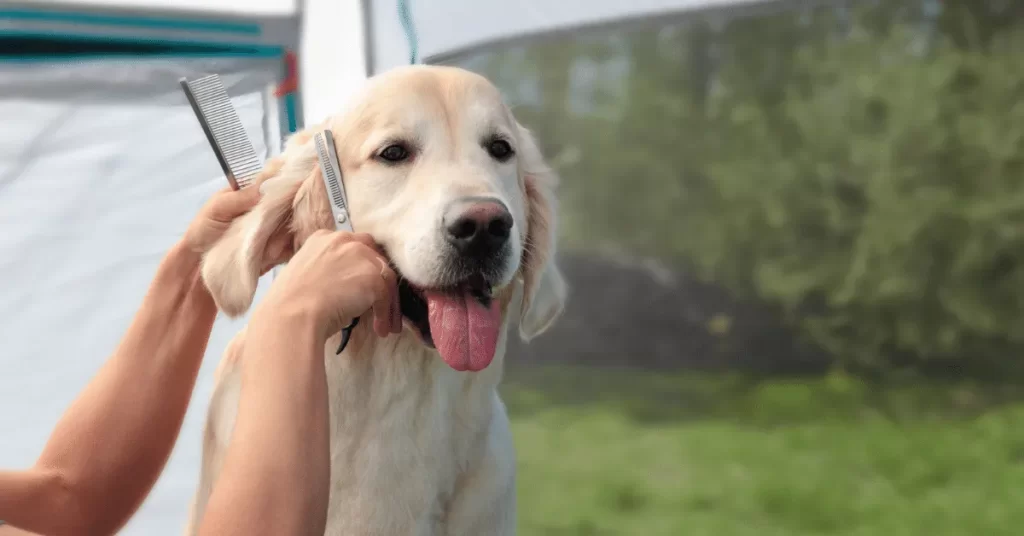Fluffy, friendly, and hyperactive: The Golden Retriever is one of the most popular dog breeds in the world.
With such a well-known breed, how do you know if a Golden Retriever is right for you? In this post, we’ll take an in-depth look at the breed’s traits and characteristics to help you decide. Read on to learn more!
History of Golden Retriever
The golden retriever is a popular dog breed worldwide. The American Kennel Club (AKC) ranks the golden retriever as its third most popular dog breed in the US, and it has been the UK’s most popular dog since 1991. In this post, we’ll walk through the history of this beautiful canine, from its origins in Scotland to modern times.
The golden retriever was first bred in Scotland by Dudley Coutts Marjoribanks, later known as Lord Tweedmouth. Marjoribanks wanted a dog that could help him retrieve ducks and other game during hunting on his estate in the Scottish Highlands. He bred water spaniels and setters with retrievers to create a dog that was strong enough to handle cold weather and water, intelligent enough to obey commands, and gentle enough not to damage the game it retrieved.
The golden retriever is often called a “golden,” but as you can see from the photos above, their coats are actually more of a light cream to deep red color. They have a double coat that is water-resistant and sheds regularly; it’s also naturally wavy or curly. Their long snouts and wide jaws make them excellent swimmers. They have webbed feet, which helps them in the water, and they’re known for their tenacity when swimming against strong currents (like the River Tweed in Scotland).
Golden retrievers have been bred since the early 1800s in Scotland and were originally meant to be gundogs (dogs used for hunting). The dogs were bred from a mix of different breeds, including the Irish Setter, Bloodhound, Water Spaniel, and Tweed Water Spaniel. Their original purpose was to retrieve shot waterfowl during shooting parties held on Scottish estates.
Golden retrievers are an extremely popular breed worldwide—they’re especially beloved in Canada and the United States. They consistently rank among the top five most popular breeds in America, according to rankings by the American Kennel Club.
Golden Retriever Appearance
The Golden Retriever is a dog with a strong and athletic build, as well as a long, silky coat. The ideal height for the breed is 21 to 24 inches and the weight should be between 55 and 75 pounds.

A long head is balanced by a medium muzzle. The nose is black on all colors of Golden Retriever except for dilute reds, where the nose can be brown. The teeth meet in a scissors bite and the eyes are brown or hazel. The ears are small, flat and hang close to the head. The tail is strong and bushy, reaching to the hocks, where it should be feathered out.
Golden Retriever Colors
There are four different colors that a Golden Retriever may have: golden, cream, light golden and dark golden (sometimes called mahogany). These colors are acceptable according to breed standards, so long as they do not have white markings or areas of white on their bodies.
Temperament of Golden Retriever
Golden Retriever dogs are the perfect companion for adventure-seekers and dog lovers alike. They’re known for their loyalty and their ability to work hard, but they can also be relaxed and friendly. Their gentle demeanor means they love to be with people and enjoy being part of the family.
These dogs are also extroverts; they love people and other dogs and can’t wait to meet both. They’ll happily greet anyone who comes to the door—even strangers—with wagging tails, kisses, and lots of love. And once you’ve become friends with one Golden Retriever, you’ve met them all: they adore their canine companions as much as their human ones!
While Golden Retrievers are very intelligent, they have a mind of their own. They like to think things through and evaluate situations before acting on them. This means they may require training at an early age but will benefit from it in the long run.
Golden Retrievers need plenty of exercise. They love going for walks and playing fetch, but they also like swimming and running around with other dogs. While some breeds may be too energetic for children, Golden Retrievers make a good pet because they’re not aggressive towards people or other animals.
Training of Golden Retriever
While all dogs are trainable to a certain extent, the Golden Retriever is one of the best breeds out there in training. Mixing a desire to please with a high intellect, Goldens are quick learners and can be molded into whatever you need them to be.
As pack animals, the breed inherently wants to make its master happy, so they take instruction well and are eager to learn tricks and new skills. It’s not unheard of for these dogs to pick up on instructions after just one or two repetitions, which is why they can do so many amazing things like being guide dogs for the blind or assisting law enforcement as cadaver dogs.

The biggest challenge you’ll face in training your Golden Retriever is getting them focused enough to pay attention. With such a kind nature, they’re often easily distracted by other people and animals—they want everyone in the world to like them! Because of this, you may have trouble getting your Golden to stay in a seat or come back when called if there’s another person around.
This doesn’t mean that you shouldn’t try training your dog, though! It just means that you’ll have to be patient during their learning process and make sure you have control over their environment.
Grooming of Golden Retriever
Golden Retriever is a wonderful dog breed that makes fantastic pets. However, they can be quite high-maintenance for grooming. In this post we’ll go over the best grooming practices for your Golden Retriever so they can live their best life.
A Golden Retriever’s coat is easier to maintain than other breeds of dog. They have a soft undercoat and a topcoat that has slightly harsher hairs. This coat protects them when swimming or working outside, so they are designed to be water-resistant.

However, Golden Retriever sheds frequently, especially during spring and fall months. You’ll want to brush them regularly (about twice a week) to reduce the amount of excess fur in your home. If you’re unable to brush them yourself, you can always schedule an appointment with a professional groomer.
Golden Retriever requires bathing about once every two to three weeks, but you can bathe them more often if necessary. If your dog has been exposed to dirt or mud and gets it all over their coat, it’s important that you bathe them as soon as possible in order to prevent infection from developing in any cuts or scrapes on their skin.
Nutrition & Diet of Golden Retriever
For nutrition and diet, Golden Retriever is like most other dogs. They need a balanced diet with high-quality protein, carbohydrates, and fats.
But there’s a catch: because Golden Retrievers are so large and active, their nutritional needs are much higher than those of smaller dogs. They need more protein and more fat, for instance—and they can handle more complex carbs than other breeds.
Let’s break it down into four categories:
Proteins
This is your dog’s primary source of energy. Protein helps your dog’s muscles grow and maintain their strength and tone. Your Golden Retriever needs high-quality protein—which means protein from meat sources (like chicken or lamb) rather than plant sources (like soy or wheat). It also means a higher percentage of protein in the food overall—look at the label on your dog food bag: if it says that the first ingredient on the list is chicken, you’re good! If the first ingredient listed is corn, you’re not! Look for foods with a 35% protein content or higher.
Fats
Fats are important for maintaining healthy skin and fur—as well as keeping your dog’s coat beautiful and shiny! Healthy fats (like omega-3 fatty acids) can also help with joint pain and heart issues. But don’t overdo it! You don’t want all that fur getting greasy.
Carbs
Dogs love carbs, but they need carbs that contain fiber that helps them maintain regular digestion. This is especially important for pups who have sensitive stomachs or other digestive issues. You should give your pup high-quality food that contains lots of fiber.
Vitamins and Minerals
Vitamins and minerals help meet the specific needs of your pup, and can help prevent some diseases or health conditions that may be more common in certain breeds.
Water
Like all dogs, golden retrievers need plenty of fresh water every day. Keep a clean dish of water available in the kitchen or wherever he spends his time to ensure he’s hydrated while you’re out and about.
Avg. daily food consumption of Golden Retriever
Golden Retriever dogs are large-sized energetic dogs. These dogs need to eat 3 to 4 cups of high-quality dry food a day, divided into two meals. They have a tendency to overeat and become overweight. So make note of that.
You can feed your Golden Retriever dog with commercial dog food or homemade food. However, it is advisable to consult your vet before changing your dog’s diet.
Health problems of Golden Retriever
Golden Retriever is a large breed of dog, and they can experience some health problems that their smaller counterparts do not.
1. Bloat: Bloat is a condition also known as gastric dilatation-volvulus (GDV). It happens when the dog’s stomach fills with air and twists. In order to prevent this from happening, divide food into two meals and exercise your Golden Retriever after eating.
2. Hip Dysplasia: This happens when the hip joint does not form properly in the puppy stage. There’s nothing you can do to prevent it from happening, but having your dog on a low-calorie diet will help to decrease the amount of stress on the joints.
3. Arthritis: This is common in larger dogs and is caused by inflammation of the joints, which causes pain and difficulty moving around. You can alleviate some of this pain by giving your Golden Retriever glucosamine supplements, making sure they are getting enough exercise, maintaining a healthy weight, and keeping them warm during colder months.
4. Eye Problems: These dogs are prone to cataracts and retinal atrophy because they have large eyes that stick out from their face slightly. Glaucoma can also be a problem, but it’s much more rare. A congenital defect in the eye called persistent pupillary membranes, which is when strands of fetal tissue remain in the eyes after birth, can also be a problem. It rarely affects vision, but it can be unsightly.
5. Elbow Dysplasia: This is a condition where the elbows are malformed and doesn’t allow the dog to walk normally. It causes pain and lameness in the legs and needs surgery to fix it.
6. Skin Allergies: These dogs can have skin problems, just like humans. They are also more prone to allergies than other breeds since their coat is so thick and fluffy.
7. Ear Infections: Golden Retriever has floppy ears, which makes them more likely to develop ear infections than breeds with upright ears. They also love to swim, which can lead to excess moisture in the ear canal, so it’s important to dry your dog’s ears thoroughly after every swim session.
8. Cancer: Unfortunately, cancer is a very common cause of death in Golden Retriever. In fact, one study found that up to 60% of deaths among this breed are because of cancer! The good news is there are things you can do to help prevent this disease.
9. Reproductive problems: Golden Retriever has an unusually high rate of pyometra, a serious infection of the uterus that requires immediate surgical treatment. They also have an increased incidence of mammary tumors (which are usually benign).
10. Heart disease: Golden Retriever is also prone to heart disease. It’s important to pay attention if your dog’s heart beats irregularly or they’re coughing or wheezing more than usual.
Costs of Golden Retriever
Raising a dog can be expensive. We’ll go over the costs of Golden Retriever dogs and what you can expect when you bring home your new best friend!
On average, the cost of a Golden Retriever puppy is anywhere from $1000 to $3,500. The price varies depending on where you live and the breeder you buy from.
Once you have your puppy, there are plenty of other costs to consider:
Food: Expect to spend around $200- $400 per year on food for your dog.
Veterinarian care: Expect to spend around $1,000 per year on vet visits and other health care needs.
Toys: If your dog is anything like mine, they love toys! It’s important for their mental health and overall well-being to have lots of toys available, so budget about $200 per year for these items.
Other supplies: Don’t forget about leashes and collars. Plan on spending at least $100 per year on these items.
Pros of Golden Retriever
These are the pros of a Golden Retriever dog:
They’re great with kids
We know the Golden Retriever for being patient and kind with children. This is likely because of their history of working as hunting dogs alongside people, so they learned to be gentle and submissive.
They’re super smart
If you want a dog that can perform tricks, there’s a good chance a Golden Retriever will learn them quickly. They’re also easy to train because they love pleasing people—so if you want to teach your dog not to pee on the carpet, it can probably learn (and quickly!).
They’re friendly
We know Golden Retriever for being friendly with everyone, from other dogs to strangers on the street.
They’re loyal
We have bred Golden Retrievers as companions for centuries, so they have a strong instinct to protect their owners.
They’re easy to train
Because we bred them as hunting dogs, they are eager to please and want to make their owners happy.
Service dogs
These dogs are among the most commonly used service dogs because of their gentle and easy-going personalities.
Good adapting capability
Golden retrievers can adapt to any environment and make the best out of it. They are also very flexible and adaptable with different people and cultures. They are not reserved or shy, but friendly and welcoming to anyone they meet.
Therapy dogs
They make good therapy dogs, as they have such a calm nature about them. This allows them to do their job without being too distracting in tense situations.
Not hypoallergenic
Their fur is not hypoallergenic; this means that if you’re allergic to dogs, you won’t be allergic to golden retrievers.
Cons of Golden Retriever
The Cons of Having a Golden Retriever dog
Exercise
Golden retrievers need more exercise than most people give them credit for. They are very high energy dogs that need at least one hour of exercise daily, or they will become bored and destructive in your home. If you do not have enough time to take them out on walks or hikes at least once per day, perhaps this isn’t the right breed for you!
They can be destructive
For instance, when they get bored, or if you leave them alone for too long, they may start chewing your furniture or other objects. This can be costly to fix.
Drooling
Drooling is common in Golden Retrievers, so if you hate the idea of sticky ears and wet dog kisses, this might not be the dog for you.
Shedding
They shed year-round and require a lot of grooming. If you don’t want to spend a couple of hours each week brushing your dog, this is not the right breed for you.
Prone to Obesity
Golden Retrievers are very prone to weight gain. If you have a Golden Retriever in your family, you need to make sure that they are getting the right amount of exercise each day and not overfeeding them.
Separation anxiety
Golden Retriever gets separation anxiety when left alone for long periods of time. If you are looking for a dog that can stay at home by itself all day while you work, then this is not the dog for you.
Conclusion
If you’re looking for a dog who will make you laugh, look no further than the Golden Retriever. They are so much fun to have around that we can’t even imagine what we would do without them! Plus, they’re great at giving hugs and kisses—which is a plus for anyone who just wants some love from their pet.
